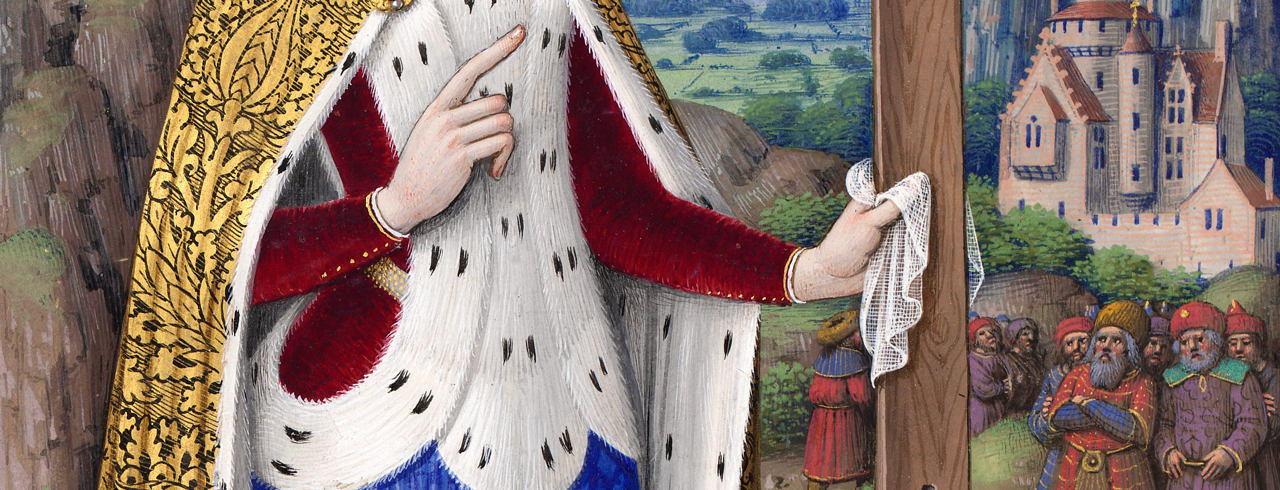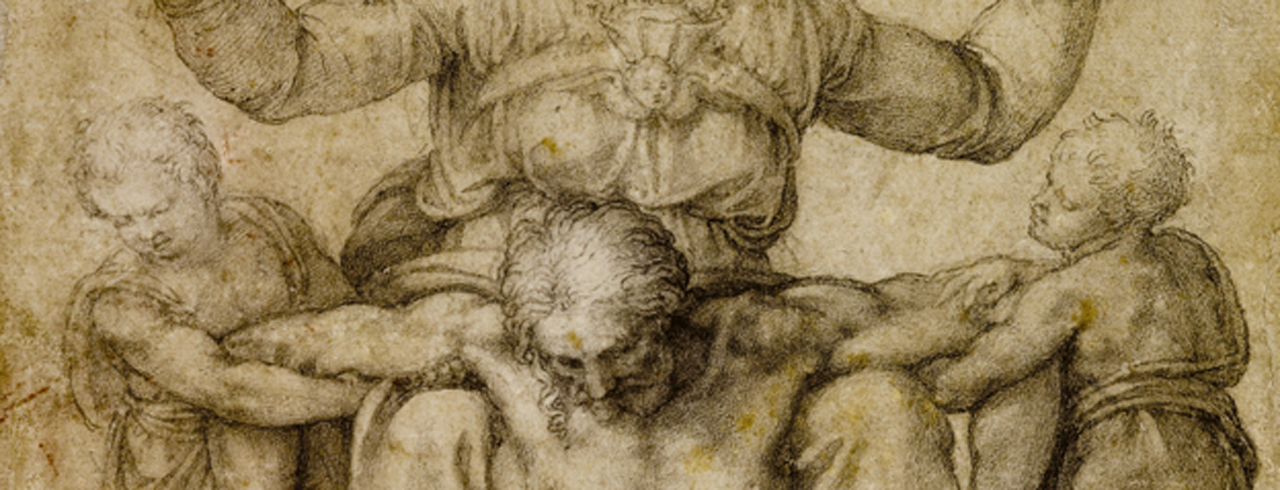-
Discover Magnificat
All you need to know about Magnificat
-
Subscribe to Magnificat
Subscribe, renew or offer a subscription

O Crux ave, spes unica! (Hail, O Cross, our only hope!)
Pierre-Marie Dumont

Study for the Colonna Pietà (c. 1538)
Michelangelo (1475–1564)
This study of the Pietà, drawn by Michelangelo in 1538, is small in size but monumental in significance. On both a personal and a theological level, it marks a major breakthrough for the sixty-three-year-old artist. Personally, it embodies Michelangelo’s gratitude towards a woman he had recently met, Vittoria Colonna. The widow of a general and a deeply religious woman, Colonna was one of Italy’s most admired poets. She became a kind of mother to Michelangelo, who had suffered throughout his life from the loss of his biological mother at the age of six. Their meeting led to a profound awakening for the artist: a new understanding of the Virgin Mary’s spiritual motherhood.
Mother and Child
There is no question that Michelangelo displayed unmatched skill across numerous disciplines—drawing, painting, sculpture, architecture, and poetry. There was one theme, however, which he struggled to depict throughout his life: the relationship between Jesus and his Mother. In many of his paintings and sculptures—such as his 1504–1506 Madonna and Child or the strained depiction of Jesus and Mary in the Last Judgement—their relationship appears somewhat cold. Michelangelo even attempted to destroy the Florence Pietà, perhaps because he was unsatisfied with its depiction of the relationship between Mother and Son. The early death of his mother may partly explain this difficulty, but there is more to it. Michelangelo was also grappling artistically with the theological virus infecting the Body of Christ—the Protestant ideology. The issue was the definition of the Church as the Body of Christ, and since Mary is both the Mother and the archetypical member of this divine body, she finds herself at the centre of the crisis.
The Colonna Pietà is one of the rare instances in which Michelangelo successfully articulates the relationship between Mary and Jesus (an even more miraculous example being the Rondanini Pietà, which he worked on right up to his death). This drawing we have is a cropped version of the original, which included the horizontal beam of the cross in the upper portion of the composition. Mary sits at the foot of the cross, her eyes and arms raised towards heaven in a gesture of supplication and offering. The lifeless body of Jesus rests between her legs, supported on either side by two assisting angels. His face is downcast, and his arms hang limply, his fingers pointing downward in a subtle indication of his descent into hell. As in the two previously mentioned examples, Mother and Son look in opposite directions, and the body language does not immediately convey love or communion. Yet there is a deeper layer of meaning in this composition.
The unusual positioning of Christ’s body—his back turned towards his Mother, his arms resting on her legs—mirrors a traditional depiction of the crucifixion known as “the Throne of Mercy”, in which the dead Christ is shown resting on the Father’s legs, while the Holy Spirit hovers between or above them. In a bold move, Michelangelo substitutes the Mother for the Father. Moreover, the girdle tied around Mary’s waist mimics the shape of a dove hovering between them. In the Colonna Pietà, Michelangelo makes a profound theological statement about the relationship between Jesus and his Mother: Through the Holy Spirit, their union reflects the lifegiving relationships within the Most Holy Trinity.
Throne of Mercy
Inscribed on the vertical beam of the cross are Beatrice’s words from Dante’s Paradiso (Canto 29): Non vi si pensa quanto sangue costa (“They know not how much blood it cost”). In sonnets he wrote around this period, the ageing artist often compared himself to Dante, “lost, in the midway of life”, entangled in the thorns of his own ego. In Vittoria Colonna, to whom he dedicated several poems, Michelangelo recognised his Beatrice: God’s chosen instrument to guide and support him toward the eternal source of all beauty.
Father Paul Anel
Pastor of Saint Paul and Saint Agnes in the diocese of Brooklyn, New York.
Study for the Colonna Pietà (c. 1538), Michelangelo (1475–1564), Isabella Stewart Gardner Museum, Boston. © Isabella Stewart Gardner Museum / Bridgeman Images.
(Read More)




On the cover of this issue of Magnificat we meet again an artist who is already familiar to us, Jean Bourdichon (1457–1521). His exquisite miniature celebrating the discovery of Christ’s cross by Saint Helen (1) (248–330) was produced between 1503 and 1508, for The Great Book of Hours of Anne of Brittany, Queen of France.
Bourdichon always illustrates the lives of the saints in such a way as to exalt their charming closeness to everyone in the communion of saints. Here, his Saint Helen is a faithful portrait of the Queen of France, Anne of Brittany, commissioner of the Book of Hours. The oval of her beautiful face is circled by the tresses of her golden hair, resembling a mandorla. Her eyes discreetly invite us to turn our hearts to behold Him who loved us first. As when Queen Anne appears in majesty, Saint Helen wears the royal crown with the fleur-de-lis motif; a royal cape of red velvet lined with ermine, with gold piping and buttons, with a clasp consisting of two floral brooches made of gold, each one adorned with four pearls and a sapphire; a gold surcoat (“waistcoat”) with an ermine panel; and an azure robe of patterned silk taffeta. Azure is the colour of the French monarchy, and ermine figures in the coat of arms of Brittany, of which Anne is the Duchess.
In order to invite his contemporaries to bring holiness into their lives, here and now, Bourdichon does not hesitate, then, to depict the scene of the finding of the True Cross by Saint Helen as though it were unfolding “today” (in the early 16th century) in Touraine. Here, then, on the right, we see the residence where Queen Anne lived with her daughters; then, in the middle of the landscape, the city of Tours; (2) and finally, in the background, the meandering Loire River with rolling hills along its banks, dominated by the famous castles. Thus, in Bourdichon’s work, the saints have come close to us, like men or women of our own acquaintance, each in his or her specific role and vocation; this is done with infinite charm to which the depths of our soul remain sensitive even today.
This year 14 September—the feast of the Exaltation of the Holy Cross—is specially highlighted, not only because it is celebrated on a Sunday (which happens every five or six years) but also because in the year of our Lord 2025 its celebration sheds a perfectly appropriate light on the fruit of the Jubilee: Hope. Indeed, on this Sunday, the Church invites us to celebrate the cross, inasmuch as it is “our only hope, in the glory of its triumph“, as the hymn Vexilla Regis puts it so well: (3)
[O Cross,] Magnificent, resplendent tree,
Empurpled by the King’s Blood;
Sacred stock, worthy to stand shoulder to shoulder
With the flesh of the All-Holy One.
Blessèd tree, on whose branches
The price of the world was suspended:
You weighed the value of this body,
So as to redeem the hostages in hell.
In the glory of your triumph, (4)
Hail, O Cross, our only hope!
Pour out grace upon the faithful;
Forgive the misconducts of sinners, as well.
And you, source of all Salvation,
Trinity whose praises the choirs of angels sing,
You, who by the cross gave us the victory:
Bestow on us for ever the crown of glory! (5)
-------------------------
Pierre-Marie Dumont
Saint Helena and the Discovery of the Holy Cross, illumination from the Great Book of Hours of Anne de Bretagne, Latin 9474, fol. 207v, Jean Bourdichon (1457–1521), Bibliothèque nationale de France, Paris. © BnF, Dist. RMN-GP / image BnF.
1 In 326 (or 327) the search expedition directed by Saint Helen, in her capacity as Augusta, mother of the Emperor Constantine the Great, discovered the True Cross of Christ, beneath the esplanade and the temple of Venus that had been planned and constructed over the place of the crucifixion by the Emperor Hadrian (76–138). It should be noted that the authentic relic of the body of Saint Helen can still be venerated in the crypt of the Church of Saint-Leu-Saint-Gilles in Paris.
2 Around 1505, in Tours, the construction of the northern tower of the Cathedral of Saint Gatien was completed; the southern tower would not be finished until forty years later.
3 In 552, Radegund, Queen of the Franks, wife of Clotaire I, son of Clovis, no longer wished to live together with the king, who had murdered his brother, so she founded the Monastery of Notre Dame and retired there as a simple nun. In 569, the Emperor of Constantinople, Justin II, sent her a piece of the True Cross discovered by Saint Helen. For the solemn reception of this distinguished relic, Radegund commissioned a hymn to be written by Venantius Fortunatus, a famous poet who later became Bishop of Poitiers: he composed the Vexilla Regis. Even today this hymn may be chanted from Palm Sunday to Good Friday, as well as on 14 September, at Evening Prayer (Vespers) of the Feast of the Exaltation of the Holy Cross. Radegund and Venantius Fortunatus were both canonised.
4 The use of this line is reserved for the feast of the Exaltation of the Holy Cross. During Passiontide, we sing: “In the time of the Passion”.
5 A literary English translation of the French translation of the hymn by the author of the commentary. Several versions of this hymn exist; it was revised over the course of the 1,546 years that have passed since its composition.
(Read More)